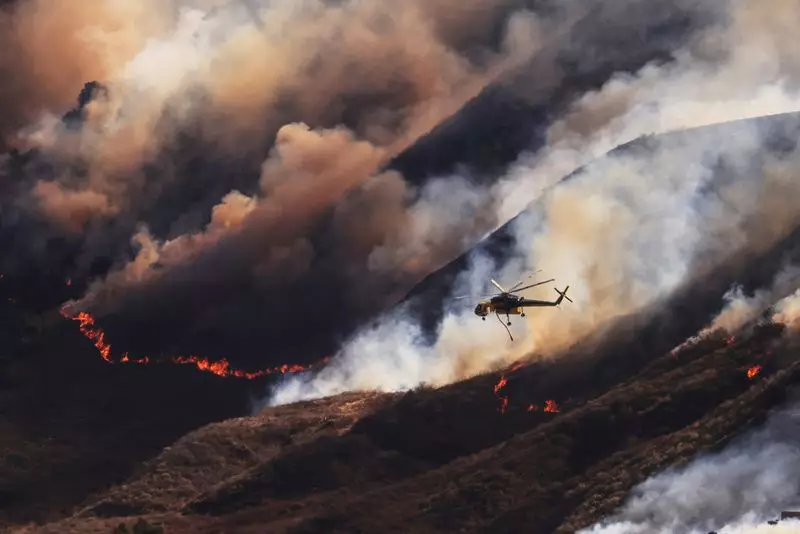The recent wildfire near Los Angeles has reignited the haunting memories of past calamities, proving once again how vulnerable communities can be to nature’s wrath. As firefighters made significant strides towards gaining control, the aftermath has left at least 132 buildings obliterated and 88 others damaged, with a startling 10,000 people initially forced to evacuate. This narrative tells a weighty tale of loss, resilience, and the relentless battle against a mercurial foe that shaped the lives of many.
The Mountain Fire, which erupted approximately 50 miles northwest of Los Angeles, was worsened by harsh conditions that carved through the region. Although estimates declared about 20,630 acres ravaged by the flames, recent updates indicated a stabilization in the firefighting efforts—now at just 14% containment, a slight bump from 7%. Officials expressed cautious optimism as they began to assert control over the inferno. It is critical to appreciate not only the physical toll of such disasters but also the emotional impact inflicted upon affected residents.
On the front lines, roughly 2,400 firefighters battled the blaze—a testament to human agency against nature. Their efforts were bolstered by a welcome shift in weather patterns. Favorable winds, moderating from the west instead of the unforgiving desert terrain, aided the team’s endeavors to contain the fire. Nonetheless, these individuals were not merely fighting flames; they were grappling with dry brush and steep inclines that made conditions treacherous. Each foot of ground gained against the fire can embody countless hours of sweat and risk.
Ventura County Fire Chief Dustin Gardner provided insights during a press briefing, celebrating the absence of external movement outside the containment lines. This encouraging news nonetheless comes with the acknowledgment that entire communities are still at peril, and a sizable block of nearly 2,000 homes remained under evacuation orders. It is crucial to observe how local authorities navigate these alerts to balance safety and a yearning for normalcy among residents eager to return home.
Among the numerous tragic accounts, Dennis Gottlieb’s story underscores the human element behind the statistics: the emotional fragmentation that ensues when homes and memories turn to ash. Waiting at a shelter with nothing but his truck left, he encapsulated the stark reality of the situation—grabbing garden hoses in a futile attempt to quench a blaze that turned ferocious. Hearing stories like his instills in us a sense of vulnerability tied directly to wildfires’ unpredictability.
“I thought I could handle it, but the reality hit hard,” Gottlieb revealed as he recounted leaving behind cherished keepsakes. His anguish is compounded by the struggle of returning to a site where virtually nothing survives. This emotional torment is echoed by Darren Kettle, whose home now consists solely of its two chimneys. The term “traumatic” denotes the complexity of feelings experienced when watching a life built over years becomes mere memories—reminders of what once was.
Investigations into the environmental responses surrounding this wildfire reveal worrying trends. Climate scientists assert that fluctuating temperatures have led to particularly dry summers, preparing California’s chaparral landscapes for devastating wildfires. The current wildfire season has also drawn attention as America has already witnessed approximately 8.1 million acres consumed—significantly surpassing the average annual figure. This troubling data forecasts a compelling narrative about climate change’s generational impact on land, society, and even policy.
In light of these increasing occurrences, meteorologists noted nuances in conditions. While recent predictions catered to lower winds and increased humidity, foreboding gusts are expected to return by weeks’ end. This cyclical nature of wildfire behavior prepares communities for ongoing unpredictability that now defines southern California.
As firefighters continue their arduous work, the dialogue surrounding recovery looms large. The initial signs are straightforward; while residents begin to return to familiar ground, millions of dollars in infrastructural damage necessitate a long road ahead. Local officials are faced with mounting pressure to assist those affected and to initiate recovery programs that address the broader implications of growing wildfire threats.
As communities grapple with their losses and struggles, the stories of resilience resonate. Individuals, families, and firefighters united against nature’s fury seek not merely closure but a collective reimagining of their futures. Community solidarity and government initiatives will undoubtedly play pivotal roles in rebuilding while fostering hope in the face of adversity.
The Mountain Fire is not just another occurrence in a forgotten narrative; it encapsulates a modern struggle colored by environmental tensions, personal resilience, and a pressing call to address climate change’s far-reaching effects.

